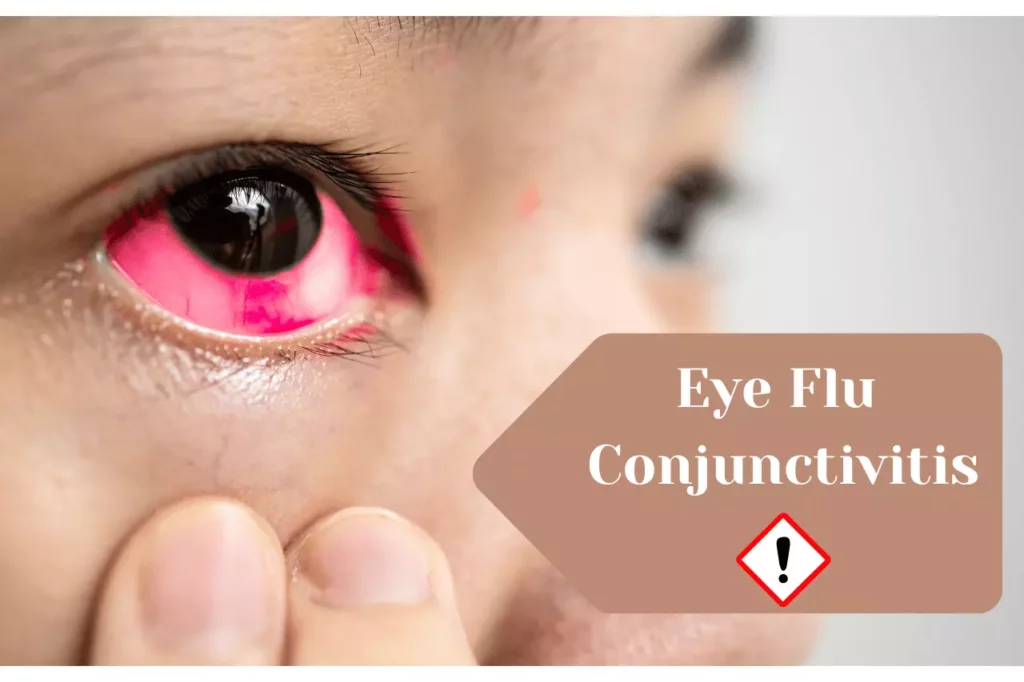What is eye flu in reality?
Eye flu, also known as “conjunctivitis”, that causes red and swollen eyes, irritation, and continuous itching in the eyes, due to which a person feels discomfort in seeing, and usually, it’s painful. It is sometimes referred to as pink eye.
In medical terminology, the inflammation of the conjunctiva (which is a thin membrane that covers the inner surface of the eyelid and the white part of the eyeball) is called eye flu. But if you want to know in general terms, it is an infection of the eye that is spreading very rapidly among people these days.
It can happen for many reasons, including allergies, bacterial or viral infections, and exposure to some environmental irritants. However, there are best practices for treating this issue both medically and through self-care.
Types of Eye Flu:
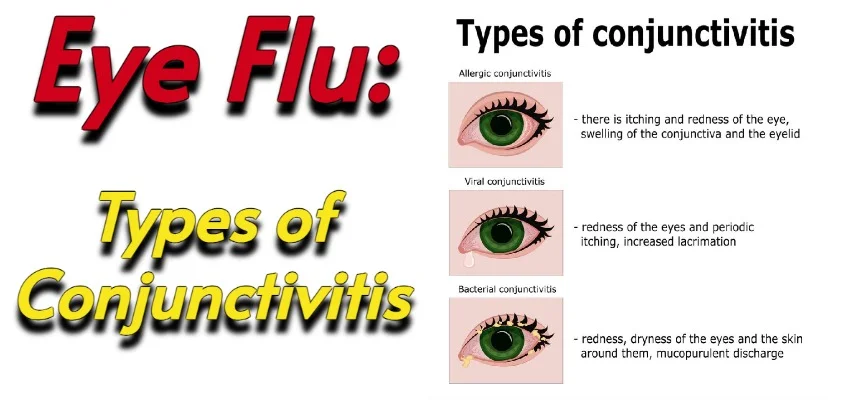
There are numerous varieties of eye flu:-
- Conjunctivitis (Pink Eye): This is a common and highly spreading Eye Flu Symptom that can be caused by bacteria, viruses, or allergens. It leads to redness of the eyes, itchiness, tears, and discharge from the eye.
- Viral Conjunctivitis: Viral conjunctivitis is highly contagious and can spread through contact with eye secretions, such as tears or mucus.
- Bacterial Conjunctivitis: This condition is brought on by bacteria and frequently causes an eye discharge that is thick, yellow, or green in colour.
- Allergic Conjunctivitis: Caused by irritants like pollen, dust, or pet dander and results in stinging redness, and watery eyes. Infection is not a factor.
- Chemical Conjunctivitis: This is basically caused when a person gets smoke, liquids, fumes, or chemicals in their eyes.
- Giant Papillary Conjunctivitis (GPC): The condition of swelling, redness, and pain on the conjunctiva, which lines the inside of your eyelids, Papillae, or lumps, may be present on your eyelid. A risk factor for this disorder is wearing contact lenses.
Causes of Eye Flu:
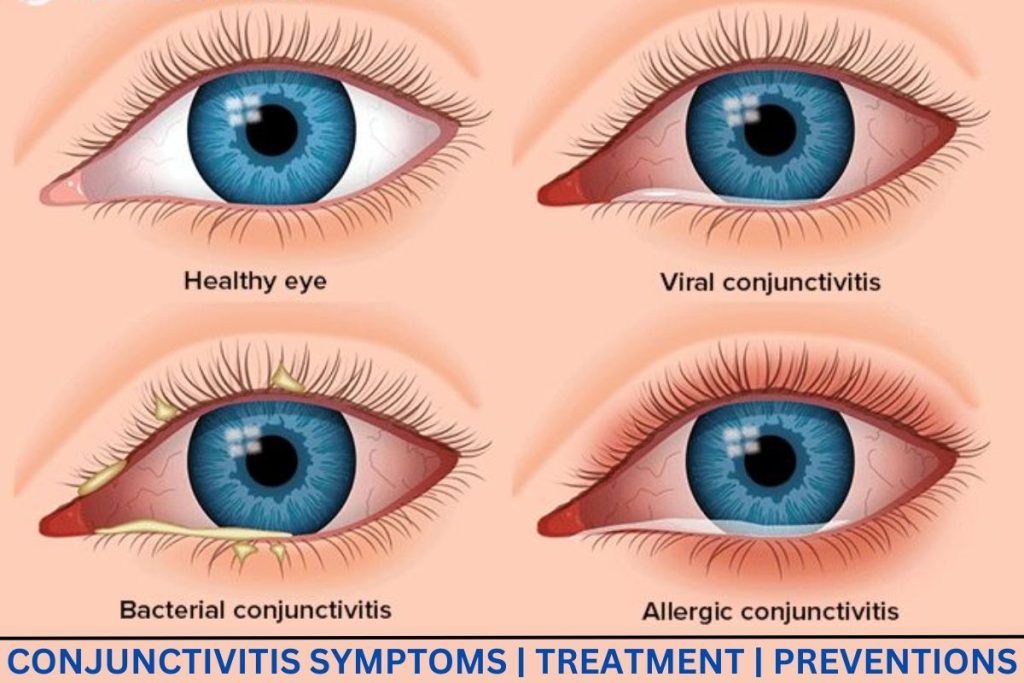
It is frequently brought on by viruses, primarily adenoviruses, although it can also be set off by other viruses like enteroviruses and herpes simplex virus. Understanding the origins and countermeasures for this illness is crucial since it can spread quickly through direct contact with infected people or contaminated surfaces.
- Viral Eye Infections: Most cases of eye flu are caused by viral conjunctivitis. Adenovirus, enterovirus, or herpes simplex virus are some examples of the viruses that cause it. Infected ocular secretions, such as mucus or tears, can spread viral conjunctivitis, which is a highly contagious condition. Additionally, contaminated objects like towels, pillows, or doorknobs can spread when people come into contact with them.
- Bacterial Eye Infections: In comparison to viral conjunctivitis, bacterial conjunctivitis is less frequent. This is triggered by bacteria like Staphylococcus aureus or Streptococcus pneumoniae. Although it is less contagious than viral conjunctivitis, it can still spread through contact with infected eye secretions or contaminated surfaces, like by touching your eyes with unhygienic hands; this is the most common reason for getting bacteria inside your eyes that leads to eye flu.
- Allergic Eye Infections: An allergic reaction to allergens including pollen, pet dander, dust mites, mould spores, or certain eye drops can result in allergic conjunctivitis, a non-infectious version of the flu that affects the eyes. Here is the primary eye flu cause for this type of allergy: The immune system releases histamines when an allergen comes into touch with the conjunctiva, which causes inflammation, redness, and stinging of the eyes. Allergy-related conjunctivitis often affects both eyes and is not contagious, in contrast to viral and bacterial conjunctivitis.
- Chemical Eye Infections: People who wear contacts are more likely to experience chemical conjunctivitis, an eye illness that is alarming. Redness, pain, and excessive tearing can be brought on by chemical exposure, such as that from swimming pools or contact lens solutions. To avoid chemical conjunctivitis, protect your eyes by exercising caution while swimming and caring for your lenses.
- Environmental Eye Infections: Conjunctival irritation caused by specific environmental conditions might cause symptoms similar to the flu in the eyes. Conjunctivitis and discomfort can be brought on by smoke, air pollution, pool chlorine, and harsh chemicals. These irritants have the potential to make the eyes red, itchy, and watery, but they do not spread from one person to another.
What are the main eye flu symptoms? Let’s know about it in detail.
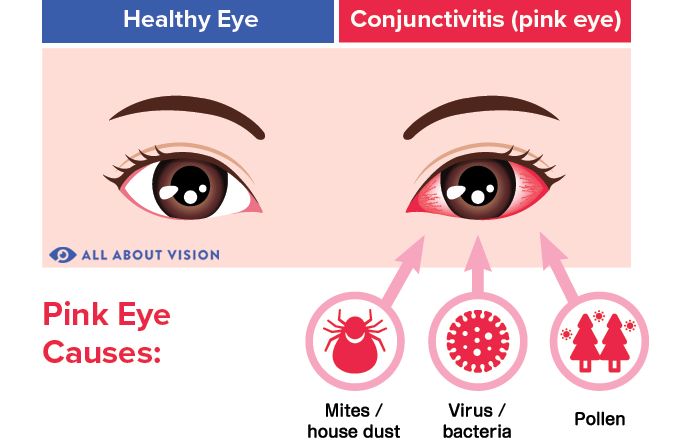
- Redness and inflammation of the eye: The most typical eye flu symptoms are redness in the white part of the eye, known as the conjunctiva, and inflammation and swelling of the eye’s delicate tissues, which can include the uvea (the middle layer of the eye), sclera (the white outer layer), and conjunctiva (the transparent membrane covering the front of the eye).
- Irritation in the Eyes: Irritation in the eyes is a common symptom of eye flu, also known as viral conjunctivitis. It’s conceivable for one’s eyes to experience an itchy, unsettling, or peculiar sensation. Upon awakening or following moments of repose, these instances of redness and discomfort tend to be more pronounced.
- Watery or discharged eyes: An additional warning sign is excessive tearing or a watery discharge from the eye. Depending on the severity of the infection, this discharge’s colour might range from clear to yellow or green.
- Pain in eyes: In the very beginning of the eye flu, most likely you will feel pain in your eyes, and because of this, you will not be able to see properly. It makes your eyes uncomfortable. But there are the best treatments for eye flu by which people can be healed from this disease.
- Light Sensitivity: Another typical sign of eye flu Symptoms are sensitivity to light, often known as photophobia. Squinting or avoiding well-lit areas might result from bright lighting, which can make the discomfort worse.
- Swollen Eyelids: In some situations, eye sickness can result in swollen, puffy eyelids. This could make you feel heavier overall and make you feel worse.
- Contagiousness: Because eye flu is a viral infection, it is quite communicable. Direct contact with sick people, the sharing of personal things, or touching contaminated surfaces are all ways it can spread. So, maintaining excellent hygiene and avoiding direct contact with those who are ill are essential to stopping its spread.
- Discomfort while sleeping: People with the eye flu may experience discomfort or pain while sleeping.
- Grittiness or Foreign Body Sensation: People with eye flu Symptoms frequently report feeling as though they have a foreign body, such as sand or grit, in their eyes. When you experience this sensation, you can feel the urge to rub your eye a lot, which could make the infection worse and spread to the other eye.
- Eyelid Crusting: Crusts may form around the eyelids in cases of bacterial conjunctivitis as a result of the discharge from the eyes drying and hardening overnight. Some people can find it difficult to open their eyes when they first awake due to these crusts.
Difference between an eye flu or another eye infection :
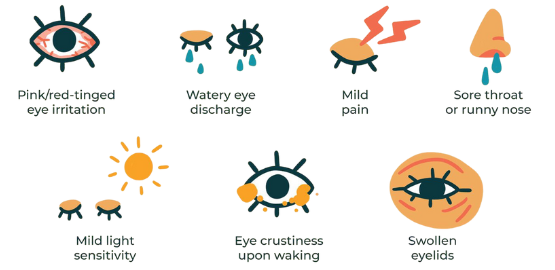
How can we determine whether it’s actually eye flu or not?
“Eye Flu” and “Normal Eye Infection” are two frequent eye illnesses that frequently cause confusion. In this manual, we’ll look at how these two ailments differ from one another so you can tell them apart and get the care you need.
Key Differences:
- Nature of the Infection: Eye flu is caused by a virus, while a normal eye infection is
- caused by bacteria. This distinction determines the type of treatment required.
- Discharge: Eye flu often presents with watery discharge, while bacterial infections tend to produce thicker and coloured discharge.
- Contagion: Both conditions are contagious, but eye flu is highly contagious and can spread easily from person to person.
- Duration: Eye flu usually resolves on its own within a week or two. Bacterial infections may last longer without treatment.
- Treatment: Eye flu typically does not require specific treatment, while bacterial infections can be treated with antibiotics.
Treatment for Eye flu:
We can have eye flu treatment through home remedies and medical treatment as well, but that totally depends on the stage and nature of our eye flu.
If you are not that sensitive and the eye flu has just started, it can be treated at home through self-care and hygiene, but don’t take it that easy if it is not curable within 2 days. You should definitely consult with your nearby eye doctor (ophthalmologist).
- Home Remedies for Eye Flu: There are a number of natural home remedies that can offer relief and help with the healing process, even though getting medical counsel is essential for an accurate diagnosis and course of treatment. We’ll look at several easy and effective home remedies in this article to deal with conjunctivitis discomfort.
- Warm Compress: You can ease the discomfort and expedite recovery by placing a warm compress over your closed eyelids. Place a clean cloth over your closed eyelids for 5 to 10 minutes after soaking it in warm water and wringing off the excess moisture to create a warm compress. To lessen redness and discomfort, repeat this multiple times each day.
- Cold Compress: Similar to a warm compress, a cold compress can help relieve swelling and itching. Use a clean cloth soaked in cold water or chilled chamomile tea bags and place them over your closed eyes for a few minutes. The cold temperature can provide immediate relief from itching and inflammation.
- Cucumber Slices: Slices of cucumber are popular for their calming effects and can cool down irritated eyes. Slices of cool cucumber should be applied to your closed eyelids. Relax for 10 to 15 minutes. Cucumbers’ water content and built-in antioxidants can lessen inflammation. One of the best eye flu treatments.
- Rose Water Rinse: One of the best treatments for eye flu is “Rose-water”. It is well known for its soothing and anti-inflammatory effects. Using an eye dropper or a clean cotton ball, gently clean your eyes with pure rosewater. To assist in cleansing and refreshing the eyes, repeat this procedure a few times each day.
- Tea Bags: You can also use tea bags ( green tea, or black tea) to reduce redness and puffiness of eyes.
- Aloe Vera Gel: The calming and anti-inflammatory qualities of aloe vera gel can help lessen pain and inflammation. Apply a small amount of gel around the eyes, making sure it is pure and organic. Avoid letting the gel get in your eyes.
- Maintain Hygiene: One of the most important things to keep in mind is good hygiene. Maintaining proper eye hygiene is crucial. Keep your hands clean at all times, and try not to touch or rub your eyes. To gently clean the region around the eyelids and get rid of any discharge, use a clean, wet towel. Regularly changing pillowcases will help to avoid contamination.
- Medical Treatment of Eye Flu: While conjunctivitis often clears up on its own, certain medical treatments can help alleviate symptoms and expedite recovery. In this article, we will explore the best and most effective medical treatments for conjunctivitis, tailored to the specific type and underlying cause of the condition.
Proper medical examinations are crucial for diagnosing conjunctivitis accurately and determining the most appropriate treatment plan. If you experience symptoms of conjunctivitis, it’s essential to seek professional medical advice. Remember that timely and accurate diagnosis contributes to effective management and a faster recovery from “eye flu.”
Here are the examination names:
- Visual Inspection: When determining the degree of redness, irritation, and discharge, healthcare practitioners should visually inspect the eyes and eyelids. The type of conjunctivitis and its potential causes are clarified by this preliminary evaluation.
- Patient History: It is essential to learn about the patient’s medical background, recent activities, and exposure to any potential allergens or irritants.
This helps in identifying possible triggers and narrowing down the underlying cause of conjunctivitis. - Slit Lamp Examination: A slit lamp, commonly referred to as a biomicroscope, is a specialised microscope used to closely examine the components of the eye. Any anomalies, such as oedema, inflammation, or foreign objects on the surface of the eye, can be found with the use of this examination.
- Fluorescein Staining: Fluorescein dye is used to identify any flaws or irregularities on the cornea’s surface during fluorescein staining. A small amount of dye is applied to the surface of the eye during this painless treatment, and the eye is then illuminated in blue to be examined.
- Bacterial and Viral Cultures: In cases where the cause of conjunctivitis is unclear, healthcare providers may collect samples from the eye for bacterial or viral cultures. These cultures help identify the specific microorganism responsible for the infection.
- Allergy Testing: Allergy testing may be suggested if allergic conjunctivitis is suspected. Finding the allergens that cause the allergic reaction might be assisted by skin or blood tests.
- Examination of Contact Lenses: For individuals who wear contact lenses, an examination of the lenses and lens care routine is essential. Poor lens hygiene or ill-fitting lenses can contribute to conjunctivitis symptoms.
- Evaluation of Discharge: Eye discharge can be collected and examined to reveal important information about conjunctivitis kind. The presence of bacteria, viruses, or other pathogens can be determined by microscopic inspection of the discharge.
Duration: For how many days does the eye flu stay?
The duration of eye flu is not set in stone; it varies based on a multitude of factors. While it may be a temporary inconvenience, understanding the different phases and factors that influence its course empowers individuals to take control of their eye health. But we can have a rough idea that the answer to the question, “How long does eye flu last?” will be 1-2 weeks.
- Viral Conjunctivitis: Viral eye flu is caused by a virus and is highly contagious. It can last for about 7 to 14 days. During this period, symptoms may gradually improve, and the eyes may become less red and irritated. However, it’s crucial to note that the virus can still be present even after symptoms improve, so practising good hygiene and avoiding close contact with others is essential to prevent its spread.
- Bacterial Conjunctivitis: Also known as bacterial eye flu, bacterial conjunctivitis is a bacterial infection that affects the conjunctiva. Bacterial conjunctivitis typically begins to improve within a day or two of receiving appropriate therapy, frequently in the form of antibiotic eye drops or ointments. Within 3 to 5 days of beginning treatment, full recovery normally takes place. To guarantee a quick and thorough recovery, it’s crucial to adhere to the recommended treatment plan.
- Allergic Conjunctivitis: Pollen, dust, or pet dander are among allergens that can cause allergic eye flu. Allergen exposure is frequently associated with how long allergic conjunctivitis lasts. It may take a few hours to a few days for symptoms to get better if the allergen is eliminated or minimised. Episodes of allergic conjunctivitis can be considerably reduced in length by managing allergies with avoidance and the proper treatments.
What precautions can be taken to avoid being affected by the eye flu?
Here are some precautions that can be taken to avoid being affected by the eye flu:
- Wash your hands frequently with soap and water: This is the most important thing you can do to prevent the spread of eye flu. Be sure to wash your hands thoroughly for at least 20 seconds, especially after using the bathroom, changing diapers, blowing your nose, or touching an infected person’s eye.
- Don’t touch your eyes: This may seem obvious, but it’s important to resist the urge to rub your eyes when they’re itchy or irritated. Touching your eyes can transfer bacteria or viruses from your hands to your eyes, which can lead to infection.
- Avoid sharing personal items: Towels, washcloths, cosmetics and contact lenses all fall under this category. These goods should first be carefully washed before being shared, if necessary.
- Get a conjunctivitis vaccination: For some forms of conjunctivitis, such as bacterial conjunctivitis, a vaccination is readily available. Consult your doctor about being vaccinated if you are at a high risk of developing conjunctivitis.
- Use Protective Eyewear: Wear the proper protective eyewear when participating in activities that could expose your eyes to irritants or infectious agents, such as swimming or being in dusty conditions. This protects against dangerous pollutants physically.
- Seek Professional Guidance: Consult an eye care specialist right away if you have symptoms like redness, irritation, excessive tearing, or discharge from your eyes. Eye flu can be stopped in its tracks and the effects on your vision can be lessened with prompt diagnosis and treatment.
What are the most effective ways to recover from the eye flu as soon as possible?
There are some parameters you can follow to get the fastest recovery from the eye flu:
- Maintain Hygiene
- Warm Compresses
- Cold Compresses
- Stay Hydrated
- Rest Your Eyes
- Stay Indoors
- Avoid Irritants
- Practice Eye Exercises
- Consult a Medical Professional
- Stay Hydrated
Is there any connection between the eye flu and the Coronavirus?
In recent times, the world has witnessed the unprecedented spread of the Coronavirus, scientifically known as COVID-19. This novel virus has triggered a global pandemic, causing widespread illness and challenging healthcare systems. Concerns regarding possible links between COVID-19 and other respiratory illnesses, such the infamous “eye flu,” are raised in the midst of this public health emergency.
We uncover an intriguing investigation of these two diseases’ potential interactions by delving into the specifics of each one.
Conjunctivitis in patients is one of the many signs and transmission routes of Covid-19 that have been the subject of much research. Conjunctival swabs contain the virus, raising the possibility of visual transmission. Conjunctivitis, eye discomfort, and excessive tears are ocular symptoms.
While the connection between eye flu and COVID-19 may not be a direct causative link, the overlapping ocular symptoms and potential for ocular transmission underscore the importance of vigilance and proactive measures.
- Awareness for the eye flu: People should be aware of the eye flu and not be careless about it, as it can have a high impact on our eye vision. Eye flu could show up as a thin thread in the tapestry of health issues. However, unravelling this thread might reveal more significant issues that influence not only specific people but also entire communities.
Weaving a universally appealing story of ocular well-being is possible by raising knowledge of the value of early detection and prevention of eye flu. Since we all have a responsibility for protecting our vision, it is not just a personal endeavour.
Conclusion
Sustaining the health of your eyes and your general well-being depends on your ability to recognise the subtleties of eye flu. We may effectively protect our eyes from this contagious condition by being aware of its signs, following preventive guidelines, and getting fast medical help when necessary.
It’s important to keep in mind that maintaining good cleanliness, avoiding crowded areas while contagious, and placing a high priority on eye health can all dramatically lower the chance of spreading eye flu. Your eyesight is a priceless gift that requires the finest care and attention, so be informed, be on the lookout, and prioritise it.

